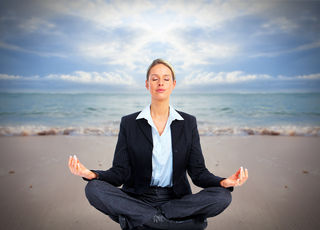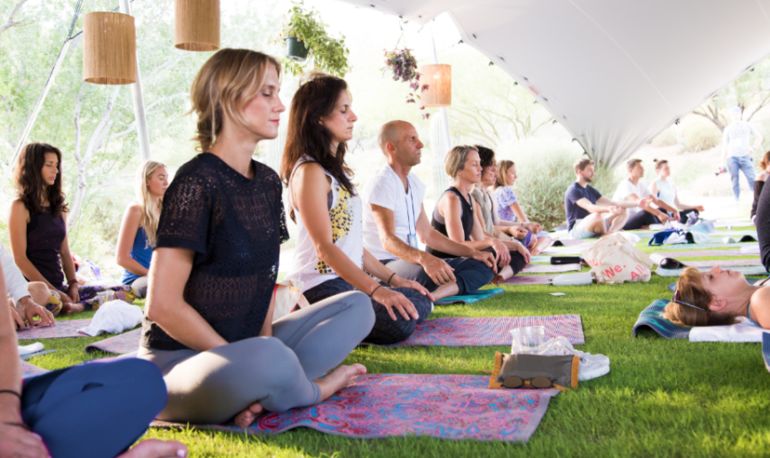I want to meditate. I really do. Everyone from celebrities to fitness instructors to neurosurgeons tell us it’s the answer to all that ails us. Having trouble at work? Meditate. Struggling with health issues? Meditate. Want to find your purpose in life? You guessed it: Meditate.
Although growing evidence supports these claims, many of us find it difficult to sit still. The idea of sitting in a quiet room, closing our eyes and chanting a mantra just makes us more anxious. We know that as soon as we get settled, the dog will bark, the phone will ring or the baby will start to cry.
“I think most everybody has trouble with meditation at first,” says Peg Baim, clinical director of training at the Benson-Henry Institute for Mind Body Medicine at Massachusetts General Hospital. “People often say, ‘I can’t meditate because I can’t sit still or my mind never stops.’”
The good news is there are types of meditation that don’t require being still. “There are other ways to break the train of everyday thought” than sitting cross-legged in a quiet room, says Dr. Herbert Benson, director emeritus of the Benson-Henry Institute. Effective meditation, he says, requires only two things: repetition of a word, a sound or a movement, and the ability to turn off everyday thoughts. When those are combined, the body naturally triggers the relaxation response, a powerful antidote to everyday stress.
Yoga, running, bicycling and walking are just some of the activities Benson recommends. Each involves rhythmic, repetitive movements that can be connected to a word or phrase — a mantra — such as “left-right” linked to footfalls, or “in-out” linked to breathing. When the meditator focuses on the mantra and how the body feels, thoughts drift away, providing relief from stress and the physiological damage it can cause.
Chronic stress has serious negative consequences for our health, say experts. According to Benson, “60 to 90 percent of physician visits” involve stress-related illnesses. That’s because we react to stress as if we are in actual physical danger. In the classic “fight or flight” response, our bodies prepare us to either confront or run away from an aggressor by increasing heart rate, elevating blood pressure and secreting hormones such as adrenaline and cortisol. In the case of real danger, these changes help us respond more quickly. Once the threat is eliminated, the body returns to normal.
But when ongoing work or personal issues are the source of stress, our bodies remain in an agitated state for extended periods of time, causing harm. Experts believe that chronic stress leads to physiological changes that exacerbate or give rise to many common maladies, including anxiety, depression, high blood pressure, digestive issues, insomnia and tension headaches.
Chronic stress has even been shown to cause changes in our DNA. While activating the relaxation response won’t cure all diseases, meditation can ameliorate them, says Benson.
Barri Leiner Grant, an author and interiors stylist from Chicago, was introduced to meditation as part of her regular yoga class. She enjoyed it so much she started going on retreats, where she learned to meditate for longer periods of time. She also used an app called Headspace, which helped make meditating a daily habit.
Leiner Grant says meditation has helped her relax and feel more grounded. She also credits it with making her a better listener and a more patient parent.
Others have seen these changes too. “People started to notice” almost immediately, Leiner Grant says. “They’d say things like, ‘You have such a nice energy, or you’re so calm.’”
Beginning an active meditation practice
Different types of meditation work for different people, says Dr. Melinda Ring, executive director of Northwestern Medicine’s Osher Center for Integrative Medicine. Whether one sits still or moves, she says, almost any activity will work as long as the practitioner has the “intention of being present, being aware and developing that mind-body connection.”
Yoga, tai chi and qi gong are especially well-suited for those who want to pursue active meditation. All three practices use movement to draw attention to the body and the breath, concentrating the mind on the present and activating what Baim calls the “adaptive network,” which “spares the brain from returning to the stress network” we usually inhabit. In addition to helping us relax, these practices increase flexibility and strength, boost circulation and improve overall health.
At Chill, a meditation center in Chicago, yoga is used to facilitate seated meditation. In one class, students prepare for meditation by first performing a series of yoga poses that stretch the legs and strengthen the body’s core muscles. This helps participants focus and makes it easier to sit comfortably for longer periods of time. “Being uncomfortable is the biggest hindrance to having a good meditation practice,” says Claire Mark, instructor and co-founder of Chill. Yoga is used “to support the meditation.”
Margo Mallar, a fundraising specialist from Barre, Mass., says she appreciates how easily she can incorporate active meditation into her day. “I can be mindfully walking (while) going from the parking lot to the grocery store,” or while walking up stairs or commuting to work, she says. When Mallar walks, she focuses her mind by counting her steps or saying a series of thank-yous in different languages. “It’s like a rosary of sorts,” she says. “It draws my attention into my body” and away from everyday thoughts.
At the Insight Meditation Society in Barre, Mass., seated meditation is alternated with walking. While both forms provide calmness and clarity, sitting emphasizes tranquility and walking emphasizes energy, says Sharon Salzberg, author and co-founder of the Society. Together, she says, they provide “a really good balance.”
Whether sitting or walking, “meditation is really about attention training,” Salzberg says. It is like strengthening a muscle “to let go gently of a distraction and then returning our attention to the original object,” which may be a mantra, the breath or awareness of the body’s movements. “We’re always letting go and coming back. That’s really the transformational aspect of meditation.”
From: Chicago Tribune



